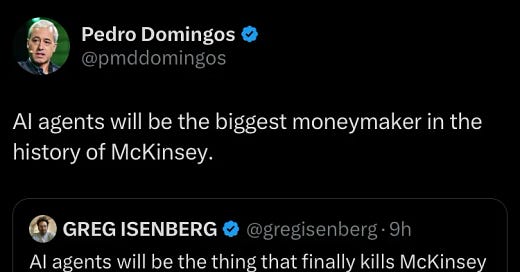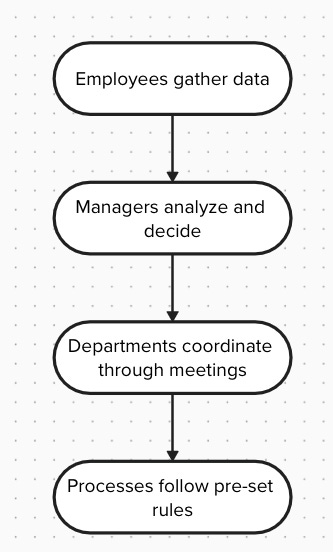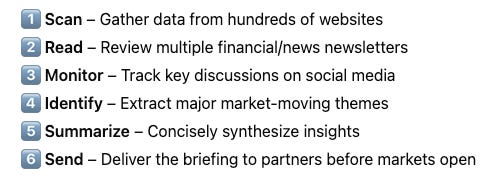The Great Rewiring (Part I)- How AI Agents Will Transform Business Operations
Part 1 of 3: Don't just add AI to old processes - rebuild around its capabilities
A few weeks ago, we explored how 19th Century factory owners initially stumbled with electricity. Eager to modernize, they simply swapped their steam engines for electric motors - and saw virtually no productivity gains. The real breakthrough came when they stopped trying to make electricity fit their old ways of working and instead reimagined their entire operation.
The winners weren't those who just bought electric motors - they were the ones who rebuilt their factories’ layout and processes around electricity's unique capabilities, creating the modern assembly line and dramatically increasing productivity. Those who clung to old methods eventually disappeared.
I believe we're at a similar inflection point with AI Agents. Today's business leaders face a similar choice: simply layer AI onto existing processes, or reimagine their operations for the age of AI agents. Now is the time to identify specific, high-impact/low risk areas where AI agents' unique capabilities can help your business. But before we dive into the agents themselves, we need to understand what they're replacing.
The Business Machine: How We Work Today
Every company is really just an information processing machine. Think about your own organization - how many hours do people spend gathering data, writing reports, creating presentations, and sitting in meetings to share that information? The modern company structure evolved to solve one basic problem: how to coordinate work when human judgment had to process everything.
However, this existing system of managing work has limitations:
Slow decision-making
Information bottlenecks
Endless coordination
Rigid processes
Over the past 150 years, we've tried different approaches to solve this:
1880s: Scientific Management (Taylorism) - Made factories efficient by breaking work into simple, repeatable tasks. Created mass production but rigid hierarchies.
1950s: Matrix Organizations - Handled growing complexity with multiple reporting lines. Created more flexibility, but created endless meetings and slow decisions.
1990s: Networked Organizations - Connected business units through technology to move faster globally. Created more autonomy, but generated overwhelming coordination overhead.
2010s: Agile Organizations - Created small, cross-functional teams for faster innovation. Better, but still hit human processing limits and couldn't scale effectively.
Each evolution helped. But the fundamental challenge remained: humans can only process so much information and do so much work, so quickly.
Now, we're at the beginning of another solution. Not just in how we process information, but in who—or what—does the processing. This is where AI agents come in.
Enter AI Agents
Think of how you use ChatGPT - you ask a question, it gives an answer. Now imagine it could act on this answer - booking meetings, sending emails, or ordering supplies. Unlike traditional automation that just follows rules, these AI agents can understand context, make decisions, and work together - taking over the information processing that currently bogs down human workers.
Consider a junior analyst preparing the morning market briefing:
A single task requires hours of human judgment. Traditional automation can only help so much.
Using an AI agent workflow (many agents working together), you could deliver a comprehensive briefing by 5am, freeing analysts to focus on strategic insights. This end-to-end workflow could be developed today and might look like this:
Data Collection Agent scrapes designated sources and organizes into structured datasets
Analysis Agent (powered by GPT-4 or Claude) identifies key themes and crafts a clear, consistent briefing following firm guidelines
Design Agent (powered by text - Image Model) creates polished visuals
Distribution Agent (Connects with Slack and Email) sends an email and Slack message by 5am
Junior Analyst (Human Work) reviews for quality any unusual findings and adding strategic insights
The real power comes when multiple AI agents work together in a coordinated workflow. Each agent has specific skills and responsibilities, like members of a highly efficient team. And as we saw last week, this isn't just changing how fast we get work done - it's transforming what we focus on and how we add value.
The Path Forward
Now we understand how work actually flows through companies today - through endless meetings, information bottlenecks, and manual processes. We also started to see how AI agents, working in automated workflows, could transform work.
But why is this time different from previous AI promises?
The short answer is that we're finally at a convergence point of four critical factors:
AI that can understand context and nuance (not just follow rules)
Tools that allow agents to work together (coordination of agents)
The ability to integrate with existing business systems
Easy to use interfaces making it easier to design these systems
In Part 2, we'll explore these factors and explore what AI agents can - and importantly, cannot - do yet. Then in Part 3, we'll get practical, showing you a simple framework to identify the right opportunities and actual tools you can
Your Next Move: Look at your organization's major processes. How much time do teams spend gathering and processing information versus making strategic decisions? Write down three processes where better information flow could dramatically improve outcomes. This inventory will be crucial as we explore implementation strategies in the coming posts.





